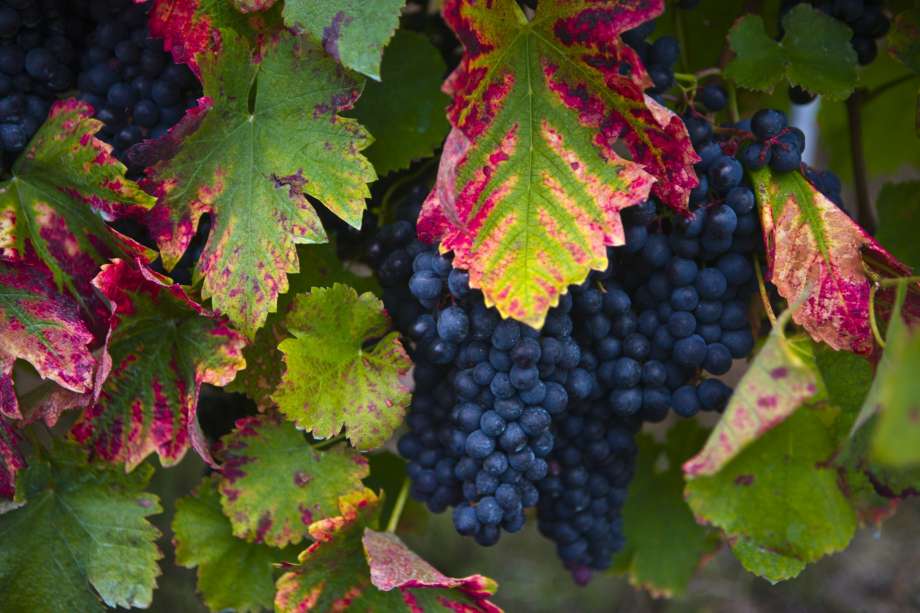
Northern Mugwort - one of the oldest grape varieties, used mainly for the preparation of wine (table and technical purpose). The origin of the variety is unknown, many sources say that the first bushes were planted several centuries ago on the Black Sea coast of Russia.
The variety is called the favorite of winemakers, it continues to grow, despite some shortcomings.
Content
Characteristics and features of the variety
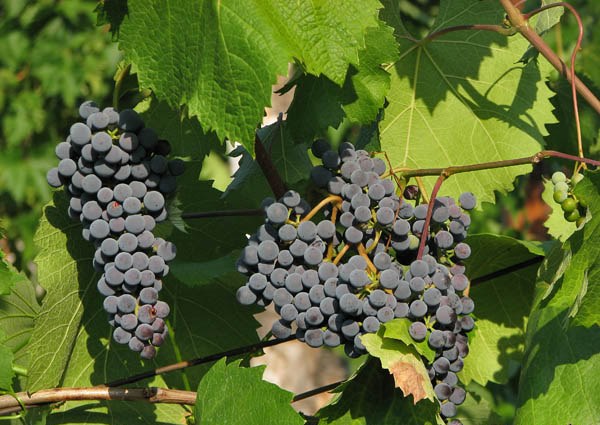
Northern shoulder grapes are grown as non-covering culture in the Central, Southern, North-Western regions, as well as in the Far East and Siberia. The variety withstands frosts up to 32 degrees, without any loss. Resistance to diseases and pests is relatively low. Ripening period is average, the period from the appearance of buds to harvesting takes no more than 140 days. Depending on the region, this is mid-August - early September. Berries that are ripe first, showered.
The variety has several more names - Goryun, because it looks like a mountain, Letun and Osypnyak (part of the ripe berries showered), Black wine, due to the color of the berries. With a shoulder and horned brush, the variety was nicknamed for the shape of the clusters.
Plant description
The bush is tall, requires a reliable, strong support. The leaves are rounded, slightly elongated, strongly dissected, divided into 5 lobes, dark green. On the upper side, the plate is decorated with a mesh of a contrasting, lighter shade, on the reverse side and on the veins there is a thick fluff. The branches are strong, flexible.
A small brush (up to 300 grams), conical or cylindrical with pronounced shoulders, individual clusters can gain mass up to 1.5 kilograms. Berries up to 3 grams, dark blue, almost black with a bluish wax coating, rounded in shape with a slightly flattened top. The taste is sweet, the aroma is unobtrusive, grape without impurities. The juice yield is up to 86%, it contains 23% sugar and not more than 9 grams of acid. The flesh is juicy, tender, there are a lot of seeds, the skin is thin, almost imperceptible.
Berry yield and application
The berries are universal in use, suitable for the preparation of desserts, juices, compotes, assorted fruits. As a technical grape, the Northern shoulder mushroom is used to make balms, sparkling and regular wines, as well as for strong alcoholic drinks. The yield is stable, an adult bush gives about 10 kilograms of berries.
Advantages and disadvantages
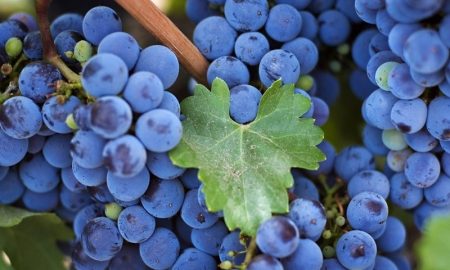
Modern hybrids and grape varieties are designed in such a way that the plant delivers as little trouble as possible when growing, yields the largest possible yields. Old varieties have mixed characteristics, they are not ideal, but stable. Advantages of the Northern Marsh:
- productivity;
- the bush does not need to be wrapped up every autumn;
- arbitrary cropping;
- universality in use.
Cons of the variety:
- weak immunity to diseases (mildew, oidium, gray rot);
- crumbling berries;
- short shelf life (no more than 3 weeks in the refrigerator);
- poor transportability.
The variety is suitable for beginner gardeners, the main thing that will have to be carefully studied is the correct system of preventative treatments. The flower is bisexual, the variety bears fruit well without pollinators, however, the best results are observed in the vicinity of Tsimlyansk black grapes. If you mix these varieties when making wine, the drink will turn out tastier than individually.
Growing Features
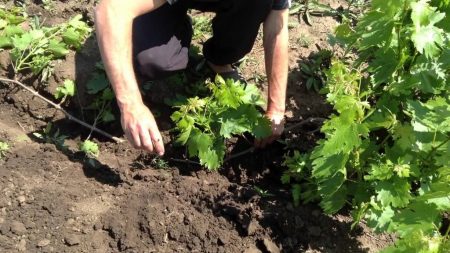
Northern shoulder grapes are very demanding on the composition and structure of the soil, as well as moisture. The soil must be permeable and fertile. Planting is carried out in the spring, when the soil warms up to a depth of 100 cm or in the fall, 2-3 weeks before the onset of frost. The place is sunny, warm, protected from strong winds. Groundwater level should be as low as possible.
Before planting, roots are necessarily cut, left no more than 15 cm, soaked in water for 2 days. Immediately after planting or before shelter for the winter, shoots shorten up to 3 buds.
When planting several bushes between them leave a distance of at least 1, 5 meters. They dig a hole 50 cm deep, prepare a soil mixture of turf land, sand, humus (one part each) and half a part of wood ash. First, a little less than half of the prepared soil is poured into the hole, compacted, a seedling is placed in the middle, the roots are straightened and covered with soil residues. The root neck is left on the surface.
At least 2 buckets of water are poured immediately under each bush, after 2 weeks the procedure is repeated. Subsequent irrigation is carried out in protracted dry periods and always in the fall before wintering. After watering and rains, the earth is loosened to a depth of 10 cm. Before the onset of frost, the bush is covered with bulk container and completely covered with earth. Shelter is necessary only in the first year after planting. In spring and autumn, the trunk circle is mulched with humus.
Mineral or organic dressing can be carried out only when necessary, when the bush is poorly developed or there are signs of starvation. However, experienced growers are advised to fertilize the variety with organics every spring, in proportion to the crop last year. Immediately after the snow melts, wood ash should be introduced into the soil - a liter per square meter, under shallow digging.
How to prune a bush
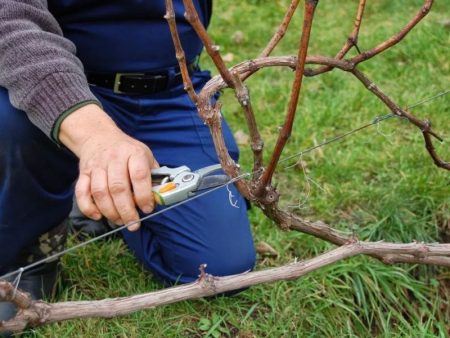
In the first year, the strongest escape of the three buds is left, the rest are cut off in the first half of July. If in the summer the branch grows to one and a half meters, it is cut into 3 leaves, and in the fall the shoot is shortened to 3-4 eyes. In the second year, choose the 2 strongest branches, directed in different directions, tie them to the trellis, pinch the rest over 3 sheets and also tie them up. Over the entire growing season, all overgrown stepchildren break out. When the shoots grow up to a meter in length, they are sent inside the bush, stepsons pinch, leaving 2-3 leaves.
In years with an excessively large crop, normalization is required. Remove excess clusters for even ripening of berries.
In the future, in the spring or autumn, you can carry out arbitrary doomsday, remove unripe, weak, excess and dry shoots. It is important not to bring to a thickening, this will negatively affect the quality of berries, the number of crops, and with dense growth of branches, the risk of developing diseases increases.
Diseases and Pests
Due to the predisposition of the Northern shoulder to the defeat of various diseases, comprehensive preventive treatments should be carried out every year. We describe the calendar of procedures in the table.
| Period | Recommended Drugs |
| Before budding, at temperatures above +4 degrees. | 3% blue vitriol, Quadris, Topaz or Strobi. |
| When the first 4-6 young leaves are formed on the shoots. | Nitrafen (200 grams per bucket of water). |
| 2 weeks before flowering. |
Mildew - 3% copper sulfate or Azophos. Oidium - Colloidal sulfur, Cumulus, Quadris and other sulfur-based preparations. |
| When the berries grow to the size of a pea. | Ridomil Gold or Topaz. |
| After leaf fall and harvesting plant debris from the site. | Skor, Topaz, Acrobat or Copper sulfate 3%. |
In summer, if signs of gray rot are found, spray the bushes with potassium permanganate of medium concentration (5-7 grams per bucket of water). During the ripening period of berries, biologics - Gamair or Alirin - are purchased for treatments. Bunches are protected from wasps by gauze bags or special nets, as well as traps with sweet fillers.
Northern shoulder painter has long been loved by winegrowers; it has already become a classic. The variety has successfully passed many years of testing in different regions of Russia, Ukraine, Belarus, Moldova and other countries. During the ripening period, in order not to lose the crumbling berries, spread or hang the polyethylene under the bushes, the collected, clean carrion can be put on a compote.
Reviews
Eugene
I live in a region with a humid climate, oddly enough, the Northern Moss has never been sick for 10 years, although many complain about its weak immunity. Given my growing conditions, I concluded that there would be no ailment if you did not plant new table varieties nearby and properly care for the bushes. I do not spend pruning “according to the rules”, every year I form a bush as I want, yields are always excellent. During the summer, I remove all fallen leaves and berries, for the winter I pour a layer of mulch.
Victoria
I’ve been growing a shoulder coat for 8 years, there is still an old bush, as far as he does not know, I got from the old owners of the dacha. I noticed an interesting detail - in one year there are a lot of clusters, they are medium in size, loose, the next season the brushes are dense and large. This happens from year to year, while the yield remains at the same level. The taste is pleasant, the berries are very sweet, a good yield of juice - the wine itself! I recommend landing, but be prepared for constant treatment of diseases.

 Non-covering winter-hardy grape varieties for Moscow region
Non-covering winter-hardy grape varieties for Moscow region How to keep the vine in winter
How to keep the vine in winter When can I transfer grapes to another place in the fall
When can I transfer grapes to another place in the fall How to cover and prepare grapes for the winter in the suburbs
How to cover and prepare grapes for the winter in the suburbs